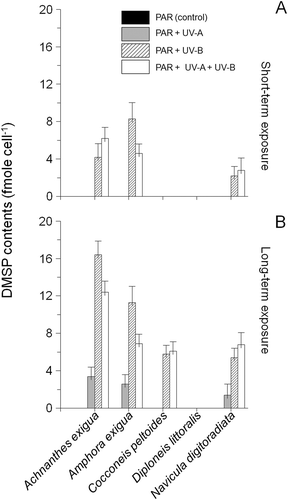Figures & data
Table 1. Characteristics of the Solthörn tidal flat isolates. all grown in f/2 medium (Guillard, Citation1975). Sampling locations in the Solthörn tidal flat, sampling dates, cell volumes (*1) and growth medium.
Fig. 1. Maximum specific growth rate (µmax, A), specific growth rate (µ, B), chl a content (C, D) and protein content (E, F) of Achnanthes exigua, Amphora exigua, Cocconeis peltoides, Diploneis littoralis and Navicula digitoradiata obtained from short- (6 h) and long-term UV (30 days) experiments. All values are means ± SD.
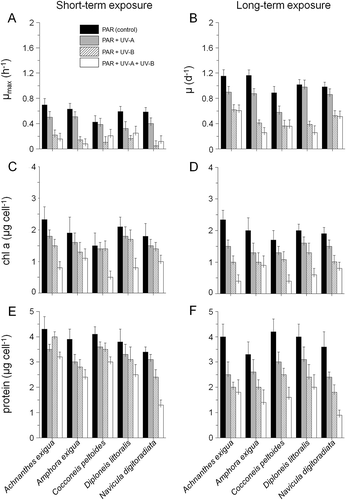
Table 2. Antioxidant effects of methanol extracts on different radical screening tests, expressed as µmol g–1 DW (mean ± SD. Assays: A1 = PAR, A2 = PAR+UV-A, A3 = PAR+UV-B, A4 = PAR+UV-A+UV-B). Abbreviations: DPPH = 2,2-diphenyl-1-picrylhydrazyl-free-radical-scavenging activity, SAS = superoxide-anion-scavenging assay, HPS = hydrogen-peroxide-scavenging activity, HRS = hydroxyl-radical-scavenging activity, FRAP = ferric-reducing antioxidant power assay, FIC = ferrous-ion chelating assay, n.d. = not determined, – = not detected.
Fig. 2. Results from phytochemical screening. Presence of phenolic compounds (A), flavonoids (B: dark grey) and tannins (B: light grey) in biomass extracts of the five isolates. Data were obtained from short- and long-term exposure to PAR, PAR+UV-A, PAR+UV-B and PAR+UV-A+UV-B. The dimensions of circles indicate slight (small circles), medium (small-medium circles), medium-strong (large-medium circles) and strong (large circles) colorimetric reactions.
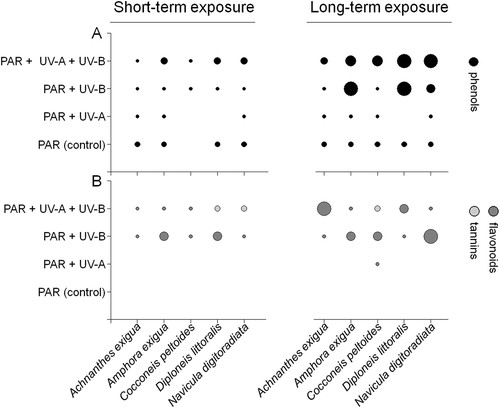
Table 3. Total polyphenolic and flavonoid content obtained from the short- and long-term UVR experiments. Data are expressed as mg 100 g-1, including mean values ± SD. Assays: A1 = PAR, A2 = PAR+UV-A, A3 = PAR+UV-B, A4 = PAR+UV-A+UV-B. Abbreviations: TPPC = total polyphenolics, TFC = total flavonoid content, – = not detected.
Fig. 3. Enzyme activities of Achnanthes exigua, Amphora exigua, Cocconeis peltoides, Diploneis littoralis and Navicula digitoradiata after 6 h exposure to PAR, PAR+UV-A, PAR+UV-B and PAR+UV-A+UV-B. (A) Superoxide dismutases (= SOD), (B) Ascorbate peroxidase (= APX), (C) Monodehydroascorbate reductase (= MDHAR) and (D) Glutathione reductase (= GR).
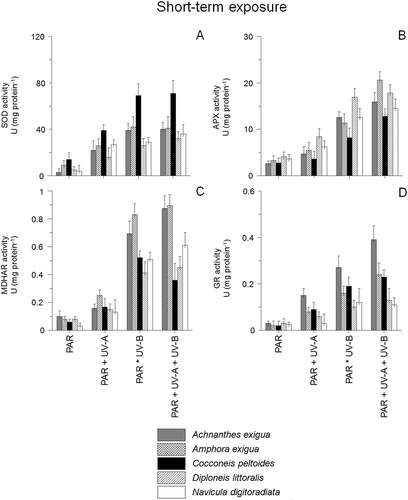
Fig. 4. Enzyme activities of Achnanthes exigua, Amphora exigua, Cocconeis peltoides, Diploneis littoralis and Navicula digitoradiata after 30 days exposure to PAR, PAR+UV-A, PAR+UV-B and PAR+UV-A+UV-B. (A) Superoxide dismutases (= SOD), (B) Ascorbate peroxidase (= APX), (C) Monodehydroascorbate reductase (= MDHAR) and (D) Glutathione reductase (= GR).
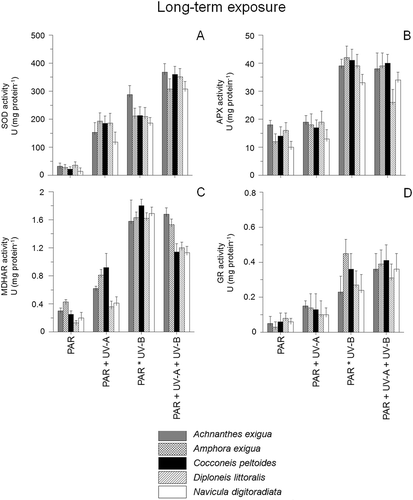
Fig. 5. DMSP content of Achnanthes exigua, Amphora exigua, Cocconeis peltoides, Diploneis littoralis and Navicula digitoradiata after 6 h (A) and 30 days exposure (B) to PAR, PAR+UV-A, PAR+UV-B and PAR+UV-A+UV-B. Values are means ± SD.
